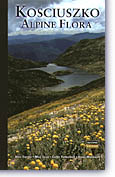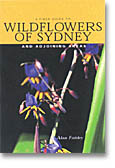|
[Front Page] [Features] [Departments] [Society Home] [Subscribe]

A Good Read
.....what's worth a look?
Reviews in this issue cover Kosciuszko Alpine Flora by Alec Costin, Max Gray, Colin Todderdell and Dane Wimbush, Australian Plant Communities - Dynamics of Structure, Growth and Diversity by Ray and Alison Specht and Wildflowers of Sydney and Adjoining Areas by Alan Fairley. |
 |

 
Kosciuszko Alpine Flora
Alec Costin, Max Gray, Colin Todderdell and Dane Wimbush
Published by CSIRO Publishing.
Hardback, 404 pages, colour (ISBN 0643065229)
AUD$59.95
(also available Field Edition, Paperback, 245 pgs, colour, $29.95)
Reviewed by Cherree Densley

"Around Australia's highest mountain lies a rare ecosystem, an alpine area of outstanding beauty and diversity, strikingly different from any other alpine ecosystems of the world. yet with common features". If there are any readers who have never visited the Mt Kosciuszko region, then 'do yourself a favour' and plan a trip . If not next year, then soon. Go in the late summer and enjoy, but take either of these books with you. You will learn so much your enjoyment and appreciation of the area will skyrocket.
212 flowering plants are photographed in glorious colour, frequently showing a backdrop of their environment - harsh, rocky, unforgiving. cold. windy and bleak - all conditions which heighten the fragility and beauty of, for the most part, tiny jewels. The photos also clearly identify the flowers, fruit and foliage, thus making identification easy. Photos of grasses, in particular are crystal clear. However, my favourite photo is on page 211 showing the wonderful Leucochrysum albicans subsp alpinum (Alpine sunray) against a rocky escarpment and that wonderful deep blue sky that is a special feature of alpine skies.
The book contains identification keys, detailed descriptions, and distribution and habitat notes for each species. A huge glossary. 265 separate listings in the Bibliography, a detailed description of the alpine and sub alpine environments, a chapter on human history and the relationship with Kosciuszko flora, a chapter of the evolution of the alpine flora and a chapter on plants and plant communities - all illustrated - give readers as much information about the area as they might possibly need. There is also a detailed map showing the vegetation patterns.
I loved this book and so will you. I can't wait to visit the area again.
Reprinted from Growing Australian, newsletter of the Australian Plants Society (Victoria), March 2001.

 
Australian Plant Communities - Dynamics of Structure, Growth and Diversity
Ray and Alison Specht
Published by Oxford University Press, 1999
Hardback, 492 pages,
AUD$126
Reviewed by Kevin Handreck
When travelling through the Australian countryside, every reader must often have wondered what has produced the many different plant communities that can be seen. In some areas tall eucalypts have an understorey of grass; in other areas the understorey is of shrubs. Some areas have few or no trees.
This variation in plant community form does not just happen by chance. Australian Plant Communities gives detailed information about how climate and soil interact to produce plant communities of different forms. And who better to write this book than Ray and Alison Specht? Many South Australians will be familiar with Ray's pioneering work at Dark Island Heath, near Keith, in the 1950s. He and his students have undertaken much of the research that is summarised in this book.
This is a source book for all those who want to understand the dynamics of the Australian 'bush'. There are chapters on the origins of our flora, and the impact of the first humans (the statement on p. 132 that indigenous Australians "had little, if any, effect on the ancient flora of Australia" is at variance with the conclusions of others, such as Tim Flannery), but most of the book is concerned with the effects of temperature, evaporation, water availability and nutrients on individual plants and their communities.
The concluding chapters deal with methods of monitoring plant communities and techniques for their management and restoration. Regarding restoration: "The task of re establishing the species richness of both overstorey and understorey is formidable ... (and) is a challenge that should test the talents of the most brilliant (plant )community physiologist..." Those of us who are less brilliant and who are involved with revegetation will appreciate this comment!
The aim of Australian Plant Communities is to provide a sound basis for the management and restoration of plant communities throughout Australia. It brings together in one place a huge amount of Australian botanical and ecological research (there are 90 pages of references).
Plant communities are not static; they are always changing, maybe slowly, but inevitably changing. Individual plants age and die, so providing gaps in which young plants can establish and grow. Fire, drought and flood have been the natural agents of change, but now in many areas invasion by weeds and feral animals, pollution and disturbance by us have accelerated change and altered its course.
Here are a few interesting snippets from the book.
- Variation in horizontal coverage by foliage is determined mainly by the evaporative power of the atmosphere: the hotter and drier the air, the lower the proportion of the ground that is covered by foliage - the Foliage Projective Cover (FPC). The FPC is close to 100% in a rainforest, but typically under 30% in the Arid Zone. For a given climatic area, the FPC is a constant, even though plant community form may vary from open woodland to heathland to grassland.
- Global warming will reduce the FPC throughout Australia (woodland will become open scrub; low open scrub will become desert).
- Leaf specific weight (weight per unit area of leaf: high for thick leaves, low for thin leaves) increases exponentially along gradients from wet coast to and interior. It is genetically determined, but moulded by evaporative stress and nutrient supply during leaf development. Dry and hot air and nutrient deficient soil give smallish, thick leaves that mature rapidly. Adding extra phosphorus and nitrogen (as around isolated trees in pastures or via sheep camps) delays leaf maturation. The lush young leaves are more readily and heavily attacked by insects and caterpillars; the new shoots that are initiated after each defoliation draw down carbohydrate reserves in the stems; the plant is gradually weakened. This is DIEBACK.
- Mangroves grow in seawater and can survive in fresh water, but if their foliage is covered for a few days with fresh water, they die.
- For mulga (Acacia aneura) to regenerate, the following sequence must occur: wet summer, long dry season or fire, series of wet seasons. That doesn't happen very often.
Readers will find hundreds of other pieces of equally interesting information about our flora. This is not a 'do it this way' book. It is a text book that provides solid information which, if applied with skill, will ensure a high rate of success for all who wish to preserve or restore areas of bush.
Reprinted from the August 2000 issue of the Journal of the Australian Plants Society (South Australia).

 
Wildflowers of Sydney and Adjoining Areas
Alan Fairley
Published by Bloomings Books, 2001.
278 pages, 280 colour plates, soft cover,
AUD$32.95
Reviewed by Patty Jansen

The latest guide for Sydney plants aims to increase appreciation for the beauty of the varied and abundant wildflowers of the region, rather than to be an exhaustive identification guide. It includes 268 species, selected on the basis of their conspicuousness, and care was taken to select a balanced number of species from both the sandstone areas of coastal Sydney and the heavier soils in the west. Especially the latter are often ignored in similar books. The book covers a few trees, but no grasses or ferns.
The text is easy to follow, with a minimum of botanical terms, and includes useful headings, such as comparison with similar species, habitat, flowering period and a selection of sites where each species may be found.
I especially like the latter feature. Many books just mention that a species is 'very common in the area', which makes you feel rather foolish if you can't seem to find any.
The main part of the book is the plant identification, but there is a small introduction to the history of botany in Sydney, and the different habitats in and around the city. There is also an index of scientific and common names, and a reference list which includes both the major identification guides to the area and books providing more background information.
The photographs are of excellent quality and good for identification purposes, although I find them a bit bland, and all too often it is rather obvious that the photographer cut some branches and held them in a bundle to photograph the flowers. This is especially obvious in some of the pea flowers, which are clearly oriented sideways in the picture and they would never have been had they been photographed on the plant.
The species are sorted alphabetically by genus. If you are familiar with plant names and can identify plants to genus, this is OK. But in writing for people who know very little about plants, this would be my least desirable arrangement choice. Many books for beginners arrange plants by flower colour, after all, this is the most obvious feature of a plant. This poses a problem when a plant is not in flower, but a beginner is not likely to notice, or want to identify, the plant in this condition. For a more thorough work, arrangement by relationship, by family, is the best choice.
Arrangement by genus separates groups that should be together, and presumes prior knowledge which the intended audience cannot be expected to have. I really find it a very poor third option.
The selection of species is generally good. There are about 1500 species in the Sydney region, and even if you take away the very small and inconspicuous plants, this leaves a lot to choose from. This calls for hard decisions to be made, and although I would have included a few different species and omitted some others, I think that the author did a pretty good job at selecting the species.
In all, I think this is a nice guide that introduces people to the beautiful wildflowers of Sydney.
Reprinted from Native Plants for New South Wales, newsletter of the Australian Plants Society (NSW), October 2001.

[Front Page] [Features] [Departments] [Society Home] [Subscribe]
Australian Plants online - March 2002
Association of Societies for Growing Australian Plants
|